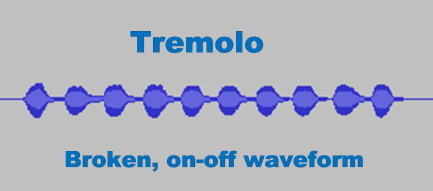
What is Tremolo?
Tremolo is similar to vibrato as a way of texturing our sound, but it’s not the same as vibrato. Think of it as a switch enabling us to fade and reintroduce the same note without any pitch shift, or else as a loop, where a note is repeated but its pitch remains unchanged. We can control this in various ways, but essentially we are creating a pulsed or interrupted waveform, as opposed to the continuous waveform of vibrato.

A common form of tremolo is when we apply a quivering texture to tunes for that roundup campfire effect. This requires hand tremolo (more commonly called hand vibrato), a technique that does not actually change the pitch of the melody notes, but instead provides a rapid on-off pulse.
 For best effect, you will need two hold the harmonica with two hands. The heels of the hands should be touching each other and not separated, as this will provide the hinge with which to work the free hand. Imagine somebody praying, or a parent covertly clapping at a school play.
For best effect, you will need two hold the harmonica with two hands. The heels of the hands should be touching each other and not separated, as this will provide the hinge with which to work the free hand. Imagine somebody praying, or a parent covertly clapping at a school play.
Ideally, the fingers of the free hand should be held together, as clawed fingers won’t provide an effective sound board with which to work the sound waves.
For a softer, more muted sound, the free hand can be cupped around the harmonica and worked from the wrist. For a more prominent tremolo, the fingers of the free hand should be pointed vertically still working from the wrist.

Students sometimes ask if they can work their free hand from the knuckles instead. This is an option for shorter and perhaps quieter bursts of hand tremolo, although it can become tiring.
The key thing is to ensure the free hand is not completely closed around the harmonica hand, but slightly open, otherwise the sound waves will remain muted and cannot be worked effectively.
Finally, consider the rate of repetition and the duration of the hand tremolo. It can be applied throughout short, western-style pieces such as Streets of Laredo, Home on the Range, or Red River Valley. Elsewhere however, a song may require more sparing application of the effect.

